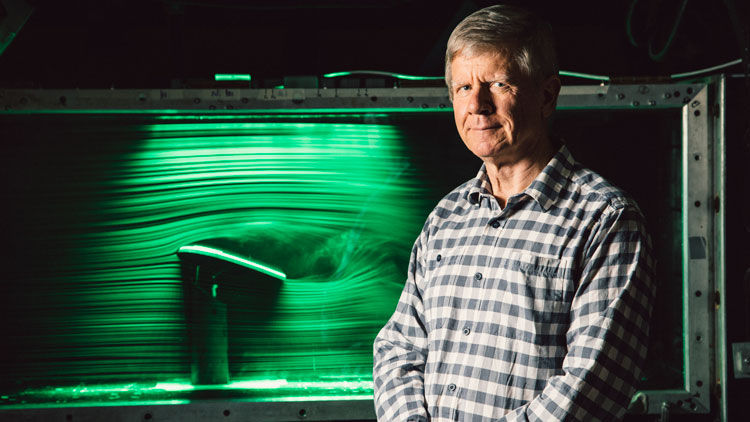Recall the aerial dogfights of World War II—where the best pilots and planes won battles—and then consider the modern need for a well-maneuvered fighter jet.
Now imagine what happens when technology exceeds the limits of the human body and pilots can no longer endure the rigors of strategic aerial moves. The choice to remove that person from the cockpit seems inevitable.
“I firmly believe that the days of manned combat aircraft are numbered,” says Professor of Mechanical and Aerospace Engineering David R. Williams, director of the IIT Fluid Dynamics Research Center. “If you remove the pilot, then that airplane becomes less expensive and much more maneuverable. And the plane that can outmaneuver an opponent in a combat situation wins.”
For example, F-16 pilots can withstand a 6 gravitational-force turn for short bursts with the help of special equipment that keeps them from losing consciousness. Pitted against an unmanned craft that can pull off a 9 g-force turn, however, they will be outmaneuvered and likely lose an aerial fight.
Leading United States defense contractors such as Northrop Grumman, Lockheed Martin, and Boeing are already building unmanned combat aircraft on a large scale, and BAE Systems (United Kingdom) and Dassault Aviation (France) boast similar projects. Without a human onboard, these aircraft require no cockpits or environmental controls for pressure or oxygen. Instead they can be designed so that their “pilots” remain on the ground and operate them from a remote terminal.
Williams and students working in IIT’s Andrew Fejer Unsteady Wind Tunnel and Supersonic Wind Tunnel are exploring how to build these aircraft so that they have the desired extra maneuverability.
“If you’re going to do these very rapid and extreme maneuvers, you’ve got to be able to predict the aerodynamic forces accurately—and you need to be able to control them,” says Williams.
The Fejer Tunnel has the ability to simulate unsteady aerodynamics—namely the gusts and drops in wind—that affect flight. By placing model aircraft wings in the tunnel’s test section, students can apply different airflow conditions, collect vital data on the variables, and then study how to adjust the airflow over the wing to maintain control of the plane.

In the Supersonic Tunnel, they are studying what happens to airflow over the wing during high angles (up to 20 degrees) of attack. “Control surfaces such as the elevators and ailerons don’t work well at high angles of attack, so we’re using the tunnel to research other ways to exert control. There are different techniques, but right now we’re using small slots where jets of air come out of the wing at critical locations and change the flow pattern over the wing to adjust the lift or drag forces on it.”
Sponsored by the U.S. Air Force Office of Scientific Research, the work supports a NATO Applied Vehicle Technology group, and serves as preliminary research for a larger-scale project to be conducted this summer at the U.S. Air Force Academy.
Williams’s aerodynamics research and the lure of working in the Fejer and Supersonic tunnels have drawn students from around the globe. “We have a student from Berlin working here on his master’s thesis and several IIT undergrads, along with graduate students from Princeton, who are using the tunnels to support their Ph.D. work,” Williams says. “We also have a collaboration with Cal Tech and UCLA, and each summer we get at least one intern from the University of Poitiers in France. So there are many connections occurring with these projects.”
Thanks to technology, we can remove people from the cockpit while still valuing the benefits of them working together on the ground.
More Online
U.S. Air Force Academy: www.usafa.af.milU.S. Air Force Office of Scientific Research: www.wpafb.af.mil/afrl/afosr
